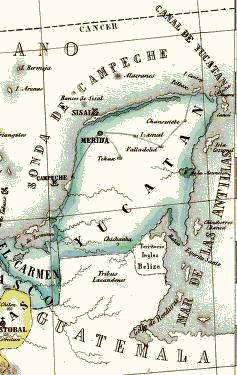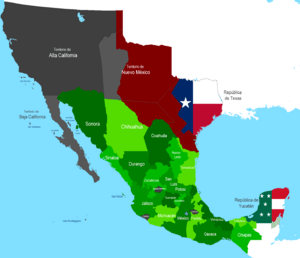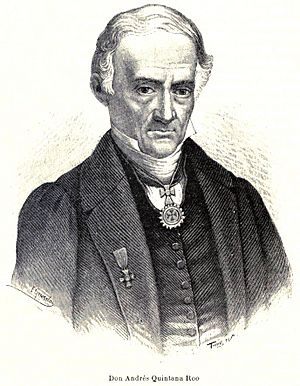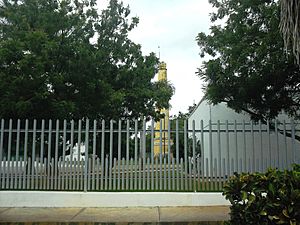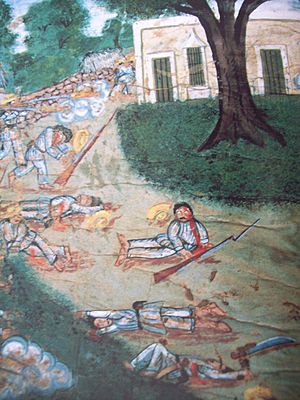Republic of Yucatán facts for kids
Quick facts for kids
Republic of Yucatán
República de Yucatán
|
|||||||||||
|---|---|---|---|---|---|---|---|---|---|---|---|
| 1841–1848 | |||||||||||
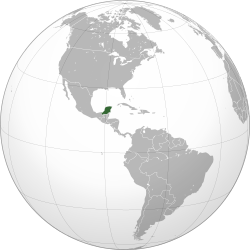 |
|||||||||||
| Capital | Mérida | ||||||||||
| Common languages | Spanish (de facto) Yucatec Maya |
||||||||||
| Religion | Roman Catholic | ||||||||||
| Government | Republic | ||||||||||
| President | |||||||||||
|
• 1840–1841 (first)
|
Santiago Méndez | ||||||||||
|
• 1847–1848 (last)
|
Miguel Barbachano | ||||||||||
| History | |||||||||||
|
• Independence
|
March 16 1841 | ||||||||||
|
• Disestablished
|
July 14 1848 | ||||||||||
| Currency | Mexican Peso ($) | ||||||||||
|
|||||||||||
| Today part of | Mexico Belize |
||||||||||
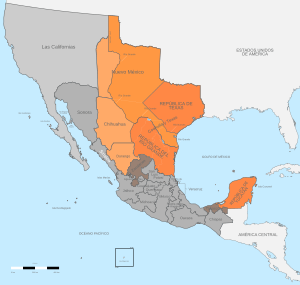
The Republic of Yucatán (Spanish: República de Yucatán) was a sovereign state that existed twice in the 1800s. A sovereign state is like an independent country.
The first Republic of Yucatán started on May 29, 1823. It chose to join the Mexican federation on December 23, 1823. This happened less than seven months later.
The second Republic of Yucatán began in 1841. It declared itself independent from the Centralist Republic of Mexico. It stayed independent for seven years. After that, it rejoined the United Mexican States.
Today, the area of the former republic includes the Mexican states of Yucatán, Campeche, and Quintana Roo. When people talk about the Republic of Yucatán, they usually mean the second one (1841–1848).
The Republic of Yucatán followed its own Constitution from 1841. This constitution protected individual rights and religious freedom. It also introduced a new legal idea called amparo, which means "protection."
In 1847, a big conflict called the Caste War started. Because of this war, the Republic of Yucatán asked Mexico for military help. Mexico agreed, but only if Yucatán rejoined the Mexican Federation.
Contents
Yucatán's Early History and Independence
In 1617, Yucatán was part of New Spain, which was ruled by Spain. Because it was far away, Yucatán had some freedom to govern itself. During Spanish rule, the region of Yucatán included what are now Campeche, Quintana Roo, Tabasco, and Yucatán. It also included parts of Petén and Belize. In 1786, Spain changed the name to Intendency of Yucatán. It still covered the same areas.
Mexico's Fight for Independence
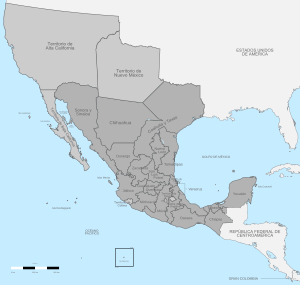
In 1810, a priest named Miguel Hidalgo y Costilla started the Grito de Dolores. This was a call for Mexico to become independent from Spain. An army of rebels fought an eleven-year war. Mexico finally won against the Spanish armies in 1821.
After winning independence, Mexico offered its crown to the Spanish king, Ferdinand VII. But Spain refused to accept Mexico's independence. So, the ejército Trigarante (Army of the Three Guarantees) took over. This army was led by Agustín de Iturbide and Vicente Guerrero. They cut all ties with Spain.
The Plan of Iguala set up Mexico's new rules. It made Roman Catholicism the official religion. It also said that all social and ethnic groups in the new empire were equal. These goals were summed up as "Religion, Independence, and Unity."
After Mexico declared independence, Agustín de Iturbide became the head of the government. He was very popular. Elections for a new Congress happened in late 1821 and early 1822. On May 19, 1822, Iturbide was made emperor of Mexico. He was called Agustin I. His coronation took place on July 21, 1822.
How Mexican Independence Affected Yucatán
Yucatán was far from Mexico City, the center of New Spain. This distance meant the war for independence in Mexico didn't affect Yucatán as much. But it did inspire people in Yucatán who wanted freedom.
Smart people in Yucatán, called the Sanjuanistas, met often. They talked about the war for independence. They met at the Church of San Juan in Mérida, Yucatán. That's how they got their name.
In 1820, Lorenzo de Zavala, a former Sanjuanista, started the Patriotic Confederation. This group split into two. One side supported the Spanish government. The other, led by Zavala, wanted complete independence from Spain.
Yucatán Joins Mexico
In 1821, the new governor of Yucatán, Echeverri, declared the peninsula's independence. He sent two people to Mexico to discuss Yucatán joining the Mexican Empire. This happened on November 2, 1821.
In December 1822, Antonio López de Santa Anna and General Guadalupe Victoria signed a plan. They wanted to end the monarchy and make Mexico a republic. Agustín I had to step down and leave the country. In May 1823, Victoria became Mexico's first president. Santa Anna became governor of Yucatán.
Yucatán joined Mexico as the Federated Republic of Yucatán on December 23, 1823. Both were founding states of the United Mexican States. The Federal Constitution of the United Mexican States of 1824 made the people of Yucatán very happy.
In Mexico, two main ideas about government were popular. The Federalists wanted power to be shared among the executive, legislative, and judicial branches. The Centralists wanted all power to be with the President. Federalists were in charge from Mexico's start as a republic until 1835. During this time, Mexico and Yucatán had good relations.
But in 1835, the Centralists took power in Mexico. They started appointing Yucatán's governor. Yucatán lost more and more of its freedom. This made its people think seriously about becoming independent and forming their own republic again.
The Second Republic of Yucatán
An important event helped set the stage for Yucatán's independence. Texas, a northern territory of Mexico, had many settlers from the United States. These settlers didn't like Mexico's centralist government. They decided to fight for their own independence. With help from US volunteers, Texas became an independent republic. Lorenzo de Zavala, a Mexican born in Yucatán, became the first vice-president of the Republic of Texas.
Yucatán Declares Independence
The federal army of Yucatán, led by Captain Santiago Imán, took the city of Valladolid. On February 12, 1840, they announced that federalism should be brought back. They wanted to bring back the Mexican Constitution of 1824.
Six days later, Captain Santiago Imán declared Yucatán's independence. This happened in Mérida, the capital. On June 6, 1840, the city of Campeche also joined the Yucatecan Federalists. Mexico's central government then declared war on Yucatán.
On March 16, 1841, a crowd in Mérida called for Yucatán's independence. They were led by Miguel Barbachano Terrazo, who would later become governor. Some people in the group took down the Mexican flag and put up a Yucatecan flag. A few days later, the Mexican flag was officially removed from all boats and buildings.
On October 1, 1841, the local government in Yucatán officially declared the independence of the Yucatán Peninsula.
The Yucatán flag was first raised on March 16, 1841. It showed protest against Santa Anna's centralist rule in Mexico. The flag has a green section on the left. On the right, it has three stripes: red, white, and red. The green section has five stars. These stars stood for the five areas Yucatán was divided into at the time: Mérida, Izamal, Valladolid, Campeche, and Tekax. The colors of the Yucatán flag are the same as the Mexican flag.
Yucatán's Constitution of 1841
The new 1841 Constitution of Yucatán was very modern. It was based on the 1825 Constitution but added new ideas. It was written by a lawyer named Manuel Crescencio García Rejón. It became law on March 31, 1841.
One important part, Article 62, brought back the Amparo. This is a legal process that limits the power of government officials.
Santa Anna's Actions and Talks with Mexico
In October 1841, Antonio López de Santa Anna became president of Mexico after a coup d'état. A coup d'état is when a group suddenly takes power. Santa Anna made his government even more centralist. He sent Andrés Quintana Roo, who was from Mérida, to talk with Yucatán's leaders. Quintana Roo was to convince them to rejoin Mexico.
Quintana Roo succeeded. Treaties were signed on November 28 and 29, 1841. These treaties allowed Yucatán to keep its own customs and tax laws. Goods could also enter Yucatán's ports freely.
But the Mexican government ignored these treaties. They demanded that Yucatán rejoin Mexico without any special conditions. They also wanted Yucatán to end all ties with the Republic of Texas, because Mexico was fighting Texas. Many attempts were made to solve these problems through talks, but they all failed.
Mexico Invades Yucatán
Since words didn't work, Santa Anna sent his army to Yucatán. In August 1842, a Mexican navy group arrived near Carmen Island. They demanded that Yucatán return to Mexico. A few days later, Mexican soldiers took the island without a fight.
Controlling Carmen Island gave Mexico a key base. It was between mainland Mexico and the Yucatán peninsula. Travel by water was the fastest way between Yucatán and Mexico. There were no land routes through the thick jungles.
Santa Anna sent 4,000 more soldiers from Veracruz to join the navy. They moved towards Campeche. This city had strong walls built long ago to protect it from pirates. The Mexican army took the city of Champoton. After failing to take Campeche, they decided to go to Mérida, the capital. The army landed at Telchac Puerto and took Telchac Pueblo, Motul, and Tixkokob.
The Mexican army reached Pacabtún's farm, near Mérida. They found out that Yucatán had prepared its defenses. The Yucatecan army was strengthened by 11,000 Mayan soldiers. On April 24, 1843, Mexican General Peña y Barragán gave up. He agreed to take his troops back to Tampico by sea.
Yucatán's Temporary Return to Mexico
Even though his army left, Santa Anna still didn't recognize Yucatán's independence. He banned ships flying the Yucatán flag from Mexican territory. He also stopped Mexican ships from going to Yucatán. This stopped all trade between Yucatán and Mexico. It caused big economic problems for Yucatán.
Barbachano knew that Yucatán had defeated Santa Anna's army. So, he decided to talk with the Mexican government. Yucatán suggested several conditions. Santa Anna agreed to give Yucatán full freedom on December 5, 1843. Yucatán started trading with Mexico again, and the Republic kept its independence.
However, this peace didn't last long. On February 21, 1844, the Mexican government said that the special rights given to Yucatán were against the constitution. In late 1845, the Mexican Congress canceled the agreements of December 1843. So, the Yucatán Assembly declared its independence again on January 1, 1846.
Second Time Yucatán Separated
Yucatán had other problems besides Mexico. The politicians in Yucatán were divided. One group was in Mérida, led by Miguel Barbachano. The other was in Campeche, led by Santiago Méndez. This rivalry was so strong that by early 1847, Yucatán had two governments.
There was also a third group: the Maya peoples. They made up most of Yucatán's military and labor force. They paid high taxes and faced unfair treatment from the wealthy white and mestizos (people of mixed heritage) who controlled the government. The Mayan people had always lived in extreme poverty. They had faced these conditions since the Spanish conquest.
On July 30, 1847, in Tepich, the Mayans rebelled. This started what became known as the Caste War.
The Méndez government faced big problems. The US Navy was blocking trade, and the Mayan uprising was growing. Méndez sent a group to Washington D.C. They argued that Yucatán should be neutral in the Mexican–American War. They said Yucatán's independence from Mexico was due to unfair actions by Mexico. They also said trade with the Gulf of Mexico was very important.
Another group, led by Justo Sierra O'Reilly, even offered to have the entire Yucatán peninsula join the United States. This idea was supported by Sierra O'Reilly.
The Méndez government managed to get back some land from the Maya. They got back cities like Izamal, Tunkás, Ticul, Tekax, and Yaxcabá. They also got Calotmul and Valladolid. Mexican troops helped them. But the Caste War eventually became too much for Yucatán to handle on its own.
In desperation, President Santiago Méndez asked for military help from the governor of Cuba, the admiral of Jamaica, and the governments of Spain and the United Kingdom. No one responded directly. However, the British did sell weapons and supplies to Yucatán through their colony in Belize. Many Yucatecan and Mayan refugees also went to Belize to escape the war.
The offer to join the United States was discussed in the U.S. Congress. The "Yucatán Bill" passed the House of Representatives but was rejected by the Senate. The war with Mexico was already complicated, and the U.S. Congress didn't want another war with the native people of Yucatán. Even though the U.S. didn't officially get involved, many American citizens fought for the Republic of Yucatán as paid soldiers. Most of them were veterans of the Mexican-American War.
Yucatán Returns to Mexico for Good
Méndez decided to give the government of Yucatán back to Miguel Barbachano. Barbachano became governor in April 1848. His first action was to tell the Mexican government about the terrible situation of the Caste War. He asked for money and military help.
Mexican President José Joaquín Herrera welcomed Barbachano. On July 14, 1848, Mexico gave Yucatán 150,000 pesos. This money came from the payment the U.S. gave Mexico for land after the Mexican-American War. Mexico also sent weapons and ammunition to Yucatán.
The Mayan rebellion was put down in August 1848. On August 17 of that year, Barbachano ordered Yucatán to rejoin Mexico. He also brought back the 1825 Constitution of Yucatán.
One result of the Caste War was that it changed the borders between Guatemala and Mexico. Since 1823, the largest northern part of Guatemala, Petén, had tried to join Yucatán. But this plan was delayed many times. It was finally dropped around 1856 as the war got worse and the Mayans won more battles.
In Fiction
- La Casta Divina is a Mexican film about Yucatán during its independence.
See also
 In Spanish: República de Yucatán para niños
In Spanish: República de Yucatán para niños
- Yucatan
- Republic of Texas
- Republic of the Rio Grande
- Revolt of 1837 (New Mexico)
- California Revolt led by Juan Bautista Alvarado
- Mexican–American War
- Caste War
- Territorial evolution of Mexico




